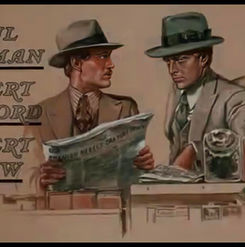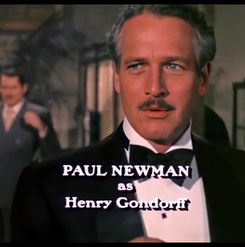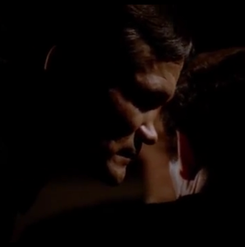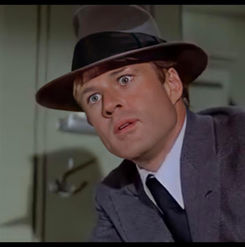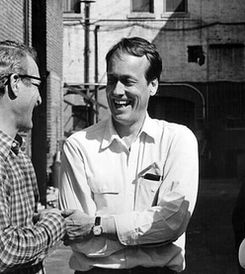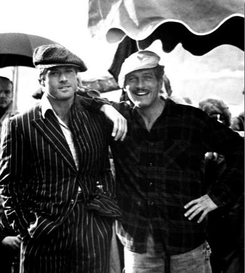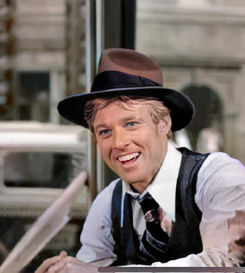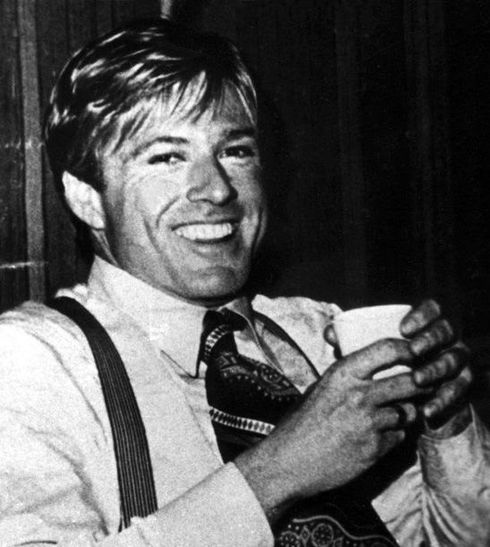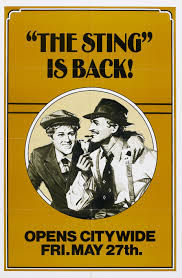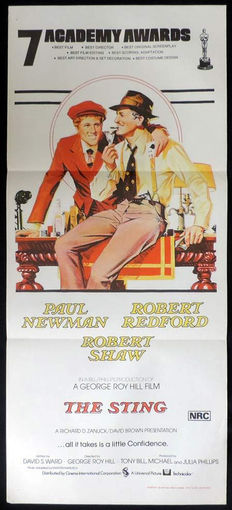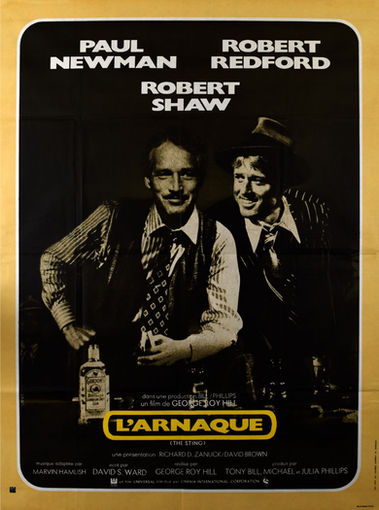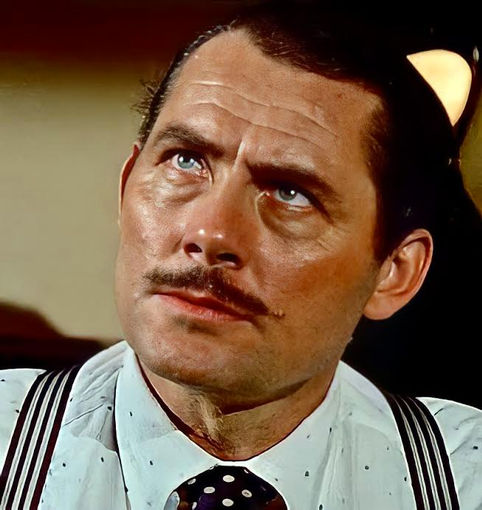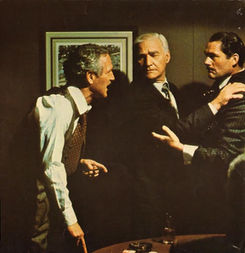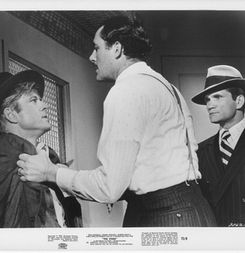

.com

Estd. 2020
Centenary
Project
2027

Approved by the Shaw Family







"The name's Lonnegan, Doyle Lonnegan"

"I guess he was one of the great English eccentrics. He seemed bigger than life. Oh, I adored him."

trailer
Robert Shaw as Doyle Lonnegan

Johnny Hooker, a small time grifter, unknowingly steals from Doyle Lonnegan, a big time crime boss, when he pulls a standard street con. Lonnegan demands satisfaction for the insult.
After his partner, Luther, is killed, Hooker flees, and seeks the help of Henry Gondorff, one of Luther's contacts, who is a master of the long con. Hooker wants to use Gondorff's expertise to take Lonnegan for an enormous sum of money to even the score, since he admits he "doesn't know enough about killing to kill him."
They devise a complicated scheme and amass a talented group of other con artists who want their share of the reparations. The stakes are high in this game, and our heroes must not only deal with Lonnegan's murderous tendencies, but also other side players who want a piece of the action. To win, Hooker and Gondorff will need all their skills...and a fair amount of confidence.
Directed by George Roy Hill
Screenplay by David S. Ward
Produced by Tony Bill, Michael Phillips, David Brown, Donald Crawford Jr., Richard D. Zanuck, Sid Sheinberg and Julia Phillips
Music by Marvin Hamlisch and Scott Joplin
Cinematography by Robert Surtees
Edited by William Reynolds
Also starring Paul Newman, Robert Redford, Charles Durning, Ray Walston, Eileen Brennan and Robert Earl Jones
Released by Universal Pictures
Release Date: December 25th 1973
Running Time: 129 minutes
Location(s): Universal Studios, Santa Monica and Chicago
Winner of 7 Academy Awards including BEST PICTURE, BEST DIRECTOR and BEST SCREENPLAY



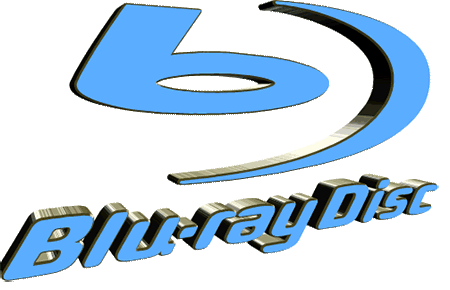







gallery






welcome to the casino

Where do you come from Kelly?
Robert Redford joins Robert Shaw in the back of Lonnegan's car for an interesting ride.
Alternative Theatrical Trailer
Alternative theatrical trailer for the international market.
The name's Lonnegan
The classic poker game scene where we are introduced to Robert as Doyle Lonnegan...ya folla???
The Producer Speaks
The Sting producer Michael Phillips discusses making The Sting in this fascinating interview.
The Poker Scene
Lonnegan and Gondorff come to blows in this iconic scene.
Official Movie Soundtrack
Enjoy tracks from the award winning soundtrack composed by Marvin Hamlisch and Scott Joplin.




![now showing GIF_thumb[1].gif](https://static.wixstatic.com/media/51f4b8_c475c3f62240416ea489b9651df68e26~mv2.gif)


PRESS PLAY



DIRECTOR
George Roy Hill
(1921 - 2002)
"Shaw is a major coup; his taciturn menace commands attention even when he is simply part of a master shot."



Paul
Newman
(1925 - 2008)

Robert
Redford
(1936 - 2025)

Charles
Durning
(1923 - 2012)

Harold
Gould
(1923 - 2010)

Ray
Walston
(1914 - 2001)

Eileen
Brennan
(1932 - 2013)

Robert Earl
Jones
(1910 - 2006)


For some reason this classic crime caper always focuses on Redford and Newman as the stars who carry the film and look at any poster and their names are the ones you'll see. The truth is, without Shaw this film would be half the film it turned out to be.
Sweeping the board at the Oscars, this is arguably Shaw's grittiest performance since Red Grant and his simmering menace shot through with a Northern Irish accent creates one of the most memorable villains in film history.
Although the film is light in tone, Shaw plays it straight as the arch criminal Doyle Lonnegan who finds himself conned by Newman and Redford in an elaborate sting. The results are stunning.
A wonderful script and legendary soundtrack compliment the stellar ensemble cast in this stunningly shot period romp which keeps you guessing right to the very end.
Newman and Redford are excellent and director Hill handles the film beautifully, but make no mistake, without the understated menace of Shaw commanding every scene he's in, this movie would not pack the sting it delivered at the box office. A masterpiece.

Lobby Card Gallery

Despite the incredible chemistry between Newman and Redford, they only made one more movie together: The Sting. It turned out to be a much bigger hit than Butch Cassidy: it won an incredible 7 Academy Awards including the Oscar for Best Picture of 1973. For fans of old-timey con men and even older-timey music, clothing and automobiles, nothing beats The Sting. It has a look, a sound and a plot-line which has rarely been used to such great affect in all Hollywood history. And yet, as with most truly great Hollywood films, its success owes nearly as much to what did not happen as to what did. . .
Screenwriter David Ward (also known for Sleepless in Seattle, King Ralph and Major League) got the idea for The Sting when he was working on his first screenplay, Steelyard Blues (1973), which includes a pickpocketing scene. Researching this, Ward found himself reading everything he could find about con artists. Ward had originally shown the screenplay which would become Steelyard Blues to producer/actor/director Tony Bill and now gave him an outline of his new story. Bill liked it immediately and brought in partners Julia Phillips and Michael Phillips; the three then produced both films.
At the time the trio first optioned Ward’s screenplay—before it was finished, based only on his telling them the story—the deal had been for him to also direct. That was nixed when Redford, sniffing around the project, said he wouldn’t do such a complicated movie with a first-timer at the helm, no offense. Once Ward saw the caliber of talent his screenplay was attracting, he came to agree with the producers that it deserved a more experienced director. Ward did eventually direct a few of his own screenplays, including Major League, King Ralph, and The Program.
George Roy Hill, who had already directed Newman and Redford in Butch Cassidy, saw the screenplay by accident and asked for the director's job. The screenplay that Hill read was quite a bit different from Ward’s earliest versions.
Originally, Paul Newman’s character (Henry Gondorff) was only in about half of Ward’s original screenplay, and was intended to be an older, paunchier fellow—a sort of gruff mentor to Johnny Hooker (who was written as an eager, raw-boned 19-year-old). At this stage of development, the producers were thinking of someone like Peter Boyle to play the role, but Newman loved the screenplay and wanted to play Gondorff no matter what. So Ward slimmed down the character and beefed up the role to fit Newman. (It turned out that Peter Boyle would appear in no less than 6 films in 1973, including major parts in Steelyard Blues and The Friends of Eddie Coyle.)
Despite the fact, as just noted, that the original Johnny Hooker was supposed to be a callow 19-year old, Ward later claimed he wrote the script with the then 37-year old Redford in mind. Redford initially turned down the part; there was simply no way he could pay a 19-year old. At this point, Ward approached Jack Nicholson who was a year younger than Redford; he turned them down as well.
When George Roy Hill – who, as previously mentioned, had directed Butch Cassidy - signed on for The Sting, Redford changed his mind and got on board. He and Newman would be reunited for a second film to be directed by George Roy Hill. Great! But there were still qualms.
Separately, Robert Redford and Paul Newman were two of the biggest movie stars in the world in the early 1970s. As a duo, they were perhaps even more popular because Butch Cassidy and the Sundance Kid was still fresh in people’s memories. But while a Butch and Sundance reunion sounded tempting (and lucrative), the studio had a concern: In the movie, the two con men’s partnership hinges on the possibility that one (or both) will try to double-cross the other.
With Redford and Newman so famously chummy, the producers were concerned that audiences wouldn’t believe such a betrayal was possible, and the film would thus lose some of its suspense. Hill convinced them he could make it work.
Even after changing his mind, Redford didn't expect the movie to be a hit. In matter of fact, he wouldn’t even see the film until 2004.
The part of merciless gangster Doyle Lonnegan was originally supposed to be played by Richard Boone, who had starred in TV’s Have Gun - Will Travel (1957-1963) and a handful of movies, including several Westerns. Boone signed on for The Sting but dropped out without explanation, refusing to even return producers’ and agents’ phone calls.
After actor Sterling Hayden turned down the role because he didn’t want to shave off his beard, the role was offered to British actor Robert Shaw. Shaw hurt his ankle playing racquetball two days before shooting began; director Hill decided to work with it and had Shaw turn his injury into a character trait.
George Roy Hill is an interesting anomaly in Hollywood history. Butch Cassidy made $102 million in 1969, or about $715 millio at today’s ticket prices. When Hill reunited Newman and Redford for The Sting, the result took in $156 million ($901 million adjusted for inflation). The Sting was the fourth highest-grossing film in history at the time, behind The Exorcist (which was released the same week), Gone with the Wind, and The Sound of Music, and ahead of The Godfather.
Butch Cassidy and the Sundance Kid was number eight, making Hill the only director to have two movies in the top 10. Hill was reclusive compared to most Hollywood directors, disliking publicity tours and talk show interviews. As a result, despite his incredible success (he also made Slap Shot and The World According to Garp), he never quite became a household name.
Viewed retrospectively, The Sting, like all truly great films, stars the only actors in the world who could have played the parts they played. That is in retrospect. As we have learned, casting a film is never as smooth or seamless as the finished product would suggest.
Production began in January of 1973. The filming was split between location shooting in Chicago, where the story was set, and on the back lot of Universal Studio in Hollywood (actually “Universal City”) California. Production got off to a rocky start. Screenwriter Ward said the only time he felt any doubt about the film’s potential was when shooting began.
He said director George Roy Hill “didn’t like what he did the first week of shooting, and thought it could be better, so he reshot it.” (It was the first sequence in the movie, the one where Hooker and Luther Coleman fleece a mobster in the alley.) Things went smoothly after that, and people praised Hill for running an efficient, happy, and well-organized set.
Hill wanted The Sting to be a stylish film that accurately reflecting not only the feel of 1930s Chicago but also that of old Hollywood films from that era. Hill, along with Art Director Henry Bumstead and Cinematographer Robert Surtees, devised a color scheme of muted browns and maroons for the film and a lighting design that combined old-fashioned 1930’s-style lighting with some modern tricks of the trade to get the visual look he wanted.
Edith Head designed a wardrobe of snappy period costumes for the cast, and artist Jaroslav Gebr created inter-title cards to be used between each section of the film that were reminiscent of the golden glow of old Saturday Evening Post illustrations - a popular publication in the 1930’s.
Hill tried to find locations in Chicago and Los Angeles that had not been touched by modern times to use for many of the scenes. In Los Angeles, locations such as The Green Hotel, the Santa Monica Carousel and The Biltmore Hotel were all used. Chicago's Union Station was also used along with LaSalle Street Station. Producer Tony Bill also contributed to the film's authentic look by helping to round up a number of period automobiles in the Southern California area.
To complete the effect, Hill made choices for The Sting that would utilize certain stylistic techniques of the 1930’s. For instance, he decided to use an old-fashioned Universal logo from the period at the beginning of the film, immediately evoking a nostalgic tone for The Sting. Hill also employed devices such as editing wipes - a type of film transition where one shot replaces another by travelling from one side of the frame to another.
As he researched old Hollywood gangster films of the 1930s for inspiration, George Roy Hill noticed that most of them didn't use a lot of extras in the scenes. "For instance," said Hill as quoted in Andrew Horton's 1984 book The Films of George Roy Hill, "...no extras would be used in street scenes in those films: Jimmy Cagney would be shot down and die in an empty street. So I deliberately avoided using extras."
Having to shoot location scenes with Paul Newman and Robert Redford - Hollywood's reigning movie stars and sex symbols of the day - proved challenging at times. Crowds would inevitably gather and reactions would be akin to the arrival of The Beatles in 1964. "I used to go see Sinatra at the Paramount in New York when I was a kid," said one observer as the cast and crew shot a scene at Chicago's Union Station, "and, my God, I never saw anything like that. I bet the temperature in here went up 22 degrees when Newman walked in." Added another onlooker at the time, "I never saw anything like it, either. Myself, I think we ought to rope off that center aisle and never let anybody use it again."
The pandemonium seemed to reach a particularly feverish pitch for Paul Newman, often to the amusement of co-star Robert Shaw. "... I did notice that it was Newman everywhere we passed through," said Shaw in a 1973 Rolling Stone interview. "I mean, I picked up about two fans on the way, and those two ladies guided me back to the station, and with great joy they introduced me to people along the way...and none of these absolute layers of girls knew who the hell I was. But they all recognized Newman, to be sure. I mean, everybody would come up and kind of swoon over him, but they didn't in Redford's case, not at all."
Newman made a point along with Robert Redford to never take such attention too seriously and instead focused on the work at hand. To keep each other grounded, Redford and Newman took turns playing practical jokes on each other. There was a good camaraderie between them, which inevitably registered on screen. "What puts Newman and Redford over so well together is as much chemistry as acting," said George Roy Hill according to the 1996 book Paul Newman by Lawrence Quirk. "When they're in the same frame something exciting happens even when they're not talking or even moving."
The movie was filmed on the backlot of Universal studios and the diner in which Hooker meets Lonnegan is the same diner interior used in Back to the Future (1985) in which Marty McFly first meets his father and calls Doc Brown. Movie magic made it possible for 1930’s Chicago, shot in 1970’s Hollywood, to appear as real as can be.
John Scarne, a one-time magician known as an authority on card games and tricks, was used as a technical consultant and poker game hand double on The Sting. It simply would have taken far too long to teach Paul Newman how to perform the card magic.
Without a doubt one of the most memorable aspects of The Sting is the ragtime music. The story is set in 1936, by which time the Scott Joplin piano tunes that serve as its soundtrack—all written between 1902 and 1908—were no longer popular.
But there was revived interest in Joplin’s work in the early ’70s, including a new recording of his catalog by pianist Joshua Rifkin that became a million-seller (quite rare for an album of “classical” music). A high-profile analysis of Joplin’s work in The New York Times soon followed, and in 1976 the composer was awarded a posthumous Pulitzer Prize for his “contributions to American music.”
Meanwhile, in the midst of this Joplin-mania, George Roy Hill heard his son playing a Joplin rag on the piano (or, according to other sources, heard Rifkin’s Joplin album) and thought the happy-go-lucky attitude of ragtime would set the perfect tone for The Sting.
When Hill first approached composer Marvin Hamlisch to adapt Scott Joplin's music for the score of The Sting, Hamlisch was reluctant. He was a composer of original music, after all, and not in the habit of adapting other musicians' work.
"I agreed to see a first cut in the screening room," said Hamlisch in his 1992 autobiography The Way I Was. "I quickly realized that this was one of the best pictures I had seen in years...David Ward had written a witty, stylish script, George Roy Hill had directed it faultlessly, and Newman and Redford were the best screen couple in years...One of the things that drew me to The Sting was that George had been shrewd enough to leave little oases without dialogue for the music. He built montages and sequences into the picture for this purpose. Whenever I see patches in a film that are talkless, I'm in heaven." Hamlisch agreed to take on the job.
Although Hamlisch wasn't a Scott Joplin aficionado, he quickly found several pieces of his that he liked and set about adapting them to suit the film. It took him a mere five days. "Writing an original theme for a film takes time, but that was not the job here," said Hamlisch. "Instead, I chose from preexisting material, and that was much easier. I quickly figured out what went where, adapted the music, timed it, cut it up, and the rest was history."
He told his agent he was done, and the agent replied, "Whatever you do, don't tell them you've finished in five days. Call them in three weeks and tell them it's coming along nicely." That is exactly what Hamlisch did.
Hamlisch had nothing but praise for director Hill. "George Roy Hill was what every director should be for a composer. If I told him I had a problem and needed a little more time in a scene to accommodate the music - or a little less - he would try to make the adjustment. He also would ask my opinion about certain scenes in the movie and how they played. That's a rare collaborator."
In addition to winning an Academy Award for his adaptation of the musical score of The Sting, Marvin Hamlisch also won two additional Oscars the same night for his work on The Way We Were.
The Sting won 6 additional Oscars, including best picture.
Producer Michael Phillips, later told an interviewer, “Believe it or not, I rehearsed my Oscar speech before we rolled our first shot. It was naive, even though it worked out that I won.” Of course, none of what he had rehearsed made it into his Oscar acceptance speech: “When I got up there, I just babbled.” The screenplay that had given him such confidence won an Oscar, too.
Elizabeth Taylor presented the Award for Best Picture. It was the first Universal Pictures film to win the award since 1930’s All Quiet on the Western Front In her brief acceptance speech, the then 30-year old Julia Phillips – the first woman to ever win a best picture Oscar - said: "You can imagine what a trip this is for a Jewish girl from Great Neck - I get to win an Academy Award and meet Elizabeth Taylor at the same time."
Edith Head won her record 8th (and final) Academy Award for best costume design.
Ever since the first foot of film was exposed for what originally were referred to as “chasers,” people have sued producers, writers and directors for plagiarism. True to form, The Sting prompted at least four separate lawsuits.
David W. Maurer sued for plagiarism, claiming the screenplay was based too heavily on his 1940 book The Big Con, about real-life tricksters Fred and Charley Gondorff (note the Newman character’s last name). Universal quickly settled out of court for $300,000, irking screenwriter David S. Ward, who had used many nonfiction books as research material and hadn’t really plagiarized any of them. (It didn’t help that Universal had quoted excerpts from Maurer’s book—properly attributed, of course—in the souvenir booklet they produced as part of the film’s publicity materials.)
Another lawsuit followed when a company called Followay Productions claimed that since they’d bought exclusive adaptation rights to The Big Con back in 1952, any movie ripped off of that book was ripped off from them, too. (The case was thrown out because Followay failed to get the author to join it.)
Paul Newman sued for a refund on California state income taxes that he paid on the money he earned on The Sting, saying he should have been charged the out-of-state rate, not the resident’s rate. (He won.) And Newman and director Hill later sued Universal for lost revenue from VHS sales on The Sting and Slap Shot. How fitting that a movie about money should have inspired so much real-life bickering about it.
A decade after The Sting, screenwriter David Ward wrote The Sting II for Redford and Newman again, and says George Roy Hill wanted to come back as director. Redford was willing to consider the project, but Newman wanted to leave well enough alone.
Universal made the sequel anyway, with Mac Davis and Jackie Gleason in the Redford and Newman roles, respectively (more or less: the characters’ names were altered, and some story details were retroactively changed). Ward wanted to take his name off as writer (or says he did), to no avail. The Sting II was released in 1983, made $6 million, and was never heard from again.

